Potential for deep geothermal energy in Scotland: study volume 2
This independent study investigates the potential for deep geothermal energy in Scotland and the steps necessary for commercialisation.
6 Abandoned mine workings
6.1 Introduction
Virtually all geological formations in the UK have the capacity to store sufficient heat to support the use of small-scale (closed loop) GSHP systems for space heating. For most of the UK, groundwater temperatures at typical abstraction depths of up to 100 m are around 10 to 12°C and essentially stable throughout the year (Ó Dochartaigh, 2009).
However, most large scale GSHP systems, serving more than a single home, are open-loop systems. Such systems generally require high abstraction rates, often in excess of 20 litres/second (l/s), from one or several boreholes (Ó Dochartaigh, 2009). This is in the upper range of potential yields from Scottish aquifers. For example, the Carboniferous sedimentary aquifers in the Midland Valley, in their natural, undisturbed state, are thought generally to form moderately productive aquifers, capable of providing borehole yields that are normally in the range 5 to 15 l/s (MacDonald et al., 2004; Robins, 1990; Ball, 1999).
Most of the abandoned mine workings in Scotland are former coal mines; however, underground mining was also used to extract ironstone, limestone, oil-shale, lead, gold, silver and other minerals ( Figure 11).
Underground mining involves the removal of rock from the ground, producing voids in the rock. In longwall and shortwall mining, much of this artificially produced void space often becomes closed again by controlled collapse of failure of roof support subsidence, but mining activity leaves a net gain in the amount of pore space in the subsurface.
The permeability of the subsurface is artificially enhanced in previously mined areas due to:
- increased void space in zones where seams were mined out;
- potential increase in fracturing in competent horizons above mined seams due to stressing during subsidence;
- remnant shafts and roadways, which provide large diameter artificial flow pathways.
Transmissivity estimates for mined rock are rare, and none are known for the Carboniferous rocks Scotland. However, there are many records of boreholes intercepting mine workings in the Glasgow area which were pumped at yields of more than 30 l/s, and at least one record of a dewatering borehole pumped at more than 150 l/s (Ó Dochartaigh, 2009).
Abandoned, sometimes collapsed, and flooded mine workings have very large surface areas (and subsurface [flooded] volumes); these rock-water interfaces provide significant potential for heat exchange (Banks et al., 2003; PB Power, 2004). This, and the associated potential high abstraction rates related to artificially enhanced permeability, makes them of interest for large, open-loop ground source heat pump systems (Banks et al., 2003).
Groundwater in mined areas is usually of poor quality ( section 6.4.3) and is otherwise an unused resource. In some cases, the water is being pumped and treated to prevent or reduce discharge of poor quality water to water courses.
The potential for abstraction of groundwater from mined areas, and utilising the heat energy it contains, is therefore greatly enhanced by mining activities. Characterising and quantifying this enhanced porosity and permeability, as well as other features of the groundwater system, is therefore needed in the development of this potentially large source of low-carbon energy using GSHP systems.
Figure 11 Localities recorded as mines in the BGS database of mines and quarries (BritPits - http://www.bgs.ac.uk/products/minerals/britpits.html). Excludes coal mines, except those in Kintyre and Brora.
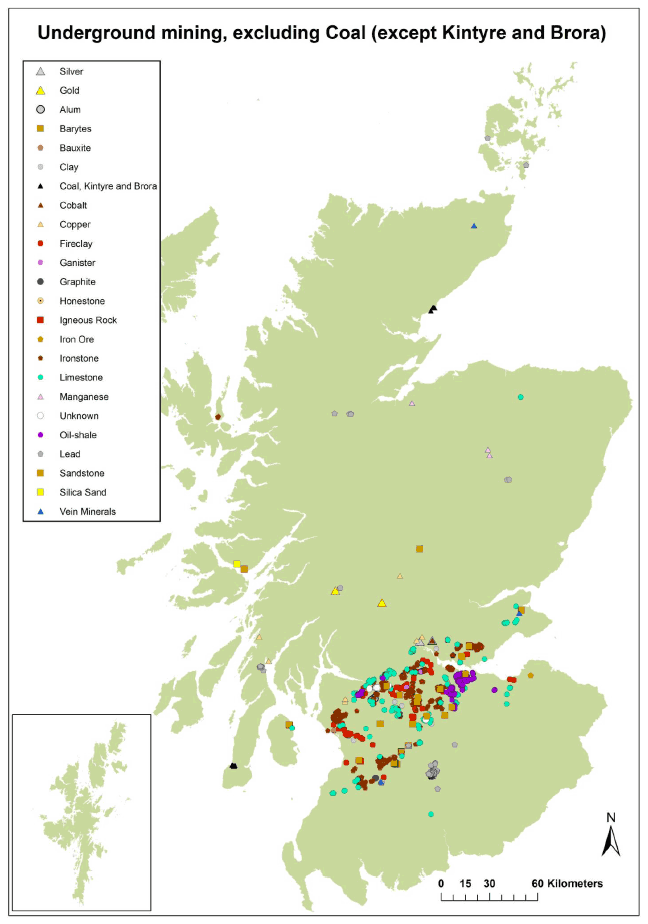
6.2 Previous studies and existing installations
Previous UK studies include the Shawfair Minewater Project: Scottish National Mine Water Potential Study ( PB Power, 2004; Appendix 1), BRE produced a report titled "Assessment of Mine water Potential in UK" in 2008 as part of the Mine water Project, which was supported by the Interreg NWE programme (Wiltshire and Burzynski, 2008).
The former study ( PB Power, 2004) considered the largest 62 coal mines in Scotland, including those with gravity flows and those being pumped. Resource assessments mainly used the number of men that worked down the mine as a proxy for the volume of mine water that might be available. The study considered the potential for mine water heating at Shawfair, near Edinburgh, as part of a consideration of the wider potential across the Midland Valley of Scotland. PB Power (2004) calculated that mine waters could contribute up to 1,708 GWh per annum of heat, if grants were provided. This equates to about 3% of their estimate of Scotland's total annual heat demand in 2004.
BGS has recently funded an internal project to make a preliminary assessment of the heat potential that is accessible as a result of Glasgow's mining legacy (Campbell et al., 2010). The assessment particularly considered the flow paths created by the mining and the potential heat-in-place (Crane, et al., 2011, unpublished BGS report).
This assessment of the geothermal potential of mine water in Scotland draws on the recent BGS work, including 3D modelling, and utilises other available data to provide an estimate of potential borehole yields and the extent of the likely resource across the Scottish coalfields. The appraisal is based on the best estimates of geological and hydrogeological properties of the mined areas, providing a different viewpoint from the earlier studies. Ironstone and oil-shale mines within the Midland Valley may also provide local potential for mine water heat recovery.
There are two existing installations of GSHPs tapping mine water in Scotland: Shettleston in east Glasgow and Lumphinnans in Fife ( Appendix 2):
i) Shettleston is a 100 m depth open loop ground source heat scheme completed in 1999 and serves 16 new-build dwellings; heat is also supplied by solar water heating and passive solar design (Sust.org, 2012).
ii) Lumphinnans is an open loop ground source heat scheme retro-fitted to a 1950s apartment block of 18 dwellings, completed in 2001. Mine water is pumped from flooded coal mine workings via a 172 m deep borehole. Banks et al. (2009) recorded that these were operating satisfactorily up to the time of reporting, although the Lumphinnans installation had suffered some vandalism which needed repair.
Operating mine water heat recovery schemes in Europe include Heerlen in the Netherlands (European Union, 2008; Roijen, 2011), Hunosa in northern Spain (Loredo et al., 2011) and Novoshaktinsk in Russia
( http://www.netinform.net/KE/files/pdf/Novoshakhtinsk_PDD_ver01_Det.pdf).
Mine water heat recovery schemes are also planned at the National Coal Mining Museum in Wakefield (Faull, 2011) and in Stoke on Trent
( http://www.stoke.gov.uk/ccm/content/council-and-democracy/communications/2012-press-releases/06-2012/134-12.en;jsessionid=aF5rFTMtHK76).
6.3 Geology and mining history
6.3.1 Coal, ironstone and oil-shale bearing strata
Coal-bearing sedimentary rocks of Carboniferous age are found in the Midland Valley of Scotland. The geology of the main coal- and ironstone-bearing strata is summarised in Table 6; the table includes a column stating whether or not each formation is known to have been mined, and how many seams were mined in the main coalfield areas of the Midland Valley.
Coal, ironstone and oil-shale bearing strata of Scotland are mainly of Carboniferous age. These sedimentary rocks are widespread across the Midland Valley of Scotland ( Figure 12). The sediments were deposited in sedimentary basin environments, with deep centres and shallow edges, forming rocks which vary considerably in thickness. For example, the Limestone Coal Formation ranges from less than 10 m thick in parts of Ayrshire to more than 550 m in the Clackmannan basin (Robins, 1990).
The sediments were mainly deposited in cycles, resulting in repeated layers of different composition: typically sandstones, siltstones and mudstones with beds of limestone, coal, fireclay and lesser amounts of ironstone and oil-shale. Each cycle can be up to about 30 m thick, but 10 m is more typical (Cameron and Stephenson, 1985). The thickness of coal seams varies, but beds of about 1 m thickness are common; some seams thicken to about 3 m in areas of greater deposition, and in some exceptional cases seams can reach 15 m thick (Rippon, 2002).
The names of the formations of interest can be confusing: the Scottish Upper Coal Measures Formation in fact contains little usable coal and was previously known as the "barren measures"; there is, however, coal in the Scottish Middle Coal Measures Formation and the Scottish Lower Coal Measures Formation. The Limestone Coal Formation contains little limestone, but does contain some of Scotland's most significant coal seams ( Table 6).
The geological structure of the Midland Valley is complex, and discrete coal seams cannot necessarily be traced across large areas. Different numbers and thicknesses of seams were mined in different areas ( Table 6).
Figure 12 Carboniferous sedimentary rocks of the Midland Valley with main coalfields named.
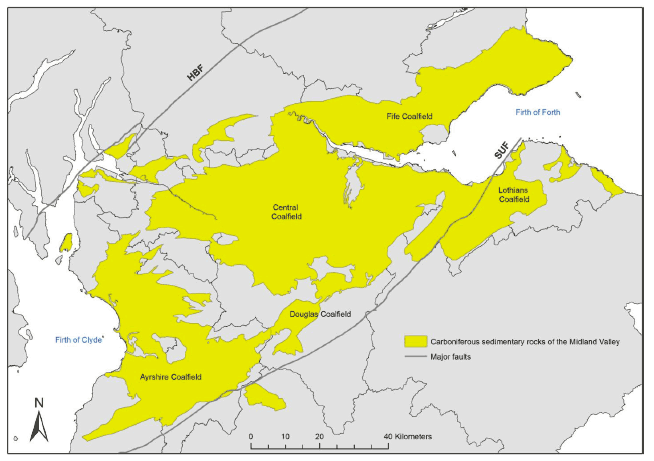
Table 6 Geology of main coal bearing strata of the Midland Valley. See Figure 12 for locations of coalfields. * Refers to oil-shale seams in West Lothian.
| Chrono stratigraphy | Lithostratigraphy | Lithological summary | Number of coal seams mined | ||||||
|---|---|---|---|---|---|---|---|---|---|
| System | Series | Group | Formation | Ayrshire | Douglas | Central | Fife | Lothians | |
| Carboniferous | Westphalian | Scottish Coal Measures | Scottish Upper Coal Measures Formation | Sandstone, siltstone, mudstone and seatearth in upward-fining successions. At least 750 m thick under the Firth of Forth and 560 m thick in Ayrshire, although not more than 300 m are preserved elsewhere onshore. | 0 | 0 | 0 | 0 | 0 |
| Scottish Middle Coal Measures Formation | Upward-coarsening sequences of coal, siltstone, and sandstone predominate. Thickness varies: between 300 and 550 m in Fife and Lothian; as little as 150 m in North Ayrshire; over 600 m at New Cumnock | 7 | 5 | 9 | 8 | 5 | |||
| Scottish Lower Coal Measures Formation | 10 | 9 | 9 | 6 | 9 | ||||
| Namurian | Clackmannan | Passage Formation | Fine- to coarse-grained sandstone with some quartz-pebble conglomerate, clayrock, seatearth and coal. Thickness varies from 10 m near Hamilton and parts of Ayrshire to 380 m in the Clackmannan basin. | 1 | 0 | 0 | 0 | 0 | |
| Upper Limestone Formation | Upward-coarsening sequences of mudstone, siltstone and fine- to medium-grained sandstone capped by seatearth and coal. Ranges in thickness from 10 m in parts of Ayrshire to 600 m in the Clackmannan basin, although to the east it is partly replaced by volcanic rocks. | 4 | 3 | 0 | 1 | 1 | |||
| Limestone Coal Formation | Repeated successions of mudstone passing upwards into siltstone and fine- to medium-grained sandstone, then seatearth and coal. Virtually no limestone. Thickness ranges from less than 10 m in parts of Ayrshire to more than 550 m in the Clackmannan basin. | 13 | 10 | 5 | 12 | 18 | |||
| Visean | Strathclyde | Lower Limestone Formation | Cyclic sequence of sandstone, mudstone, coal, and marine limestone. | 0 | 0 | 0 | 0 | 0 | |
| Tournasian | Inverclyde | West Lothian Oil Shale Formation; Clyde Plateau Volcanic Formation; Gullane Formation; Arthur's Seat Volcanic Formation | Sandstone, siltstone, mudstone, oil-shale and seatrock, with some coal seams, ironstone and limestone. | 0 | 0 | 0 | 0 | 13* | |
Coal mining has been an important part of the Scottish economy for many centuries, a consequence of the abundance of coal-bearing strata and range of coal types. There are records of coal mining activity in Scotland dating back to the 12 th Century (Craig, 1991), although the scale of mining was very small until the late 16 th Century.
Early underground workings were shallow and either dry or gravity drained. Such drains are likely to remain today, and thus the workings may still be dry. Production increased dramatically following the invention of pumping machinery, and particularly James Watt's improved steam engine of the late 18 th Century (Craig, 1991). Dewatering of mines, by pumping to lower the water table, enabled mining in much deeper workings.
Stoop and room (also known as pillar and stall) mining, where stoops of rock are left unmined to support the roof of the mine ( Figure 14), was the most common extraction technique in Scotland until the mid 20 th Century (Younger et al., 2002).
Figure 13 Layout of stoop and room mine workings. Plan view on left and profile view on right. (Younger and Adams, 1999).
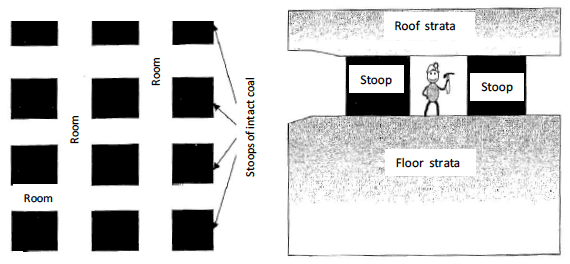
Since the 1950s, most underground mining has used the longwall method of extraction (Rippon, 2002). In longwall mining the coal seam is worked between two parallel access roadways ( Figure 15). A drum shearer breaks up the coal as it moves from the roadway at one side of the panel to the other. Moving roof supports protect the area directly adjacent to the coal face, but as the shearer advances (or retreats, depending on the system), the roof is allowed to collapse. The coal panel between the roadways is typically 100 to 250 m wide (Younger et al., 2002). Deep (underground) mining ceased in Scotland when Longannet Colliery closed in 2002 (Rippon, 2002).
On abandonment, pumping stopped in most mines and water levels have largely rebounded or are still rebounding. Pumping continues in a limited number of mines, to prevent or minimise surface discharges of poor quality water.
Figure 14 Layout of typical longwall mine workings (Younger and Adams, 1999).
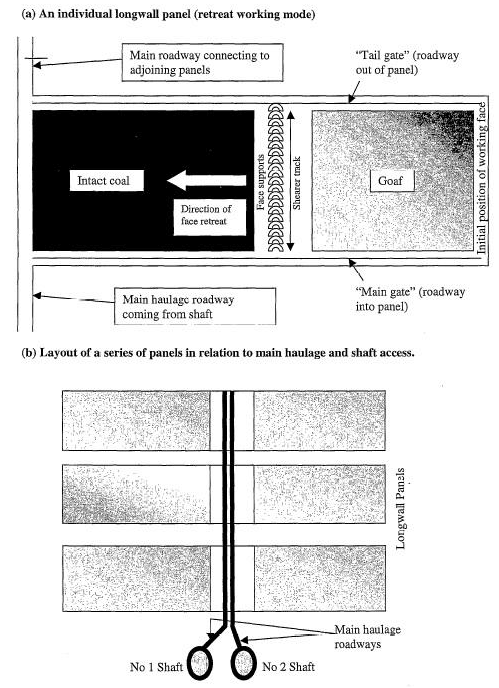
Cannel coal (also known as boghead Coal and torbanite) was used to produce "Paraffin Oil" - the first plant in Britain to process mineral oil commercially was set up in Bathgate in 1851. It gave an oil yield of 535 to 580 litres/tonne, but the deposit was exhausted within 12 years. Around the same time oil-shale was discovered in West Lothian and identified as a raw material suitable for the production of shale-oil and replaced cannel coal in the retorting and refining processes.
West Lothian is unusual in the British Isles in having oil-shale seams that are thick and widely developed. Oil-shale mining reached its maximum productivity in the early years of the twentieth century, with outputs of more than three million tons of oil-shale. Although oil-shales are developed at over a dozen horizons within the West Lothian Oil-shale Formation, three multiple, thick shale units produced the bulk of the mined oil-shale: the Broxburn Shale, Dunnet Shale and Pumpherston Shale (Barron et al., 2006). By 1950, production had declined to 740 943 tons produced at half a dozen mines and three opencast sites.
6.4 Hydrogeology of abandoned mines
Mining radically alters the hydrogeology of impacted areas, though the effects vary depending on factors such as the method of mining and the number and thickness of mined seams. The key impact is to increase the permeability of the strata above the mined horizon(s), making it easier to obtain usable yields of groundwater.
6.4.1 Open shafts, roadways and drifts
Many shafts, roadways and other linear access structures such as drifts (see Younger et al., 2002 for definitions) were built to last, and will remain as open voids in the subsurface today. Where these are beneath the water table and remain open they will be zones of extremely high permeability. They are typically interconnected, so large sustainable abstractions might be obtained.
6.4.2 Increased post-subsidence porosity and permeability
Detailed modelling and analysis of mine workings in the Glasgow region (Campbell et al., 2010; Crane et al., 2011, unpublished BGS report) indicated that stoop and room mining formed a relatively small proportion of the total mining. In stoop and room mining the roof is supported by pillars (stoops) of rock that are left in situ during mining operations ( section 6.3.2). After mining work is complete, and assuming collapse has not taken place, the voids (rooms) occupy around 50% of the mine volume.
Longwall mining involves the removal of sequential strips of coal and associated collapse of the worked strips. On collapse, the voids are filled with broken overburden (called goaf or gob), and concomitant subsidence occurs at the surface. It has been estimated that about 20% of the mined void would remain after longwall mining-induced subsidence has occurred (Younger and Adams, 1999).
The mechanism of subsidence induced by longwall mining creates stresses in the overlying strata which have been well studied and are summarised in Figure 16. Applying this model to typical longwall panel widths (W) of 100 to 250 metres indicates that some 40 to 100 metres of strata above the mined seam will be fractured due to the subsidence; this volume of rock therefore has enhanced permeability (Younger and Adams, 1999). Thinner zones above this will be affected by compression and extension ( Figure 16).
The mined horizon is likely to remain the most permeable zone even though, post-subsidence, it contains broken goaf. Younger and Adams (1999) suggested that this will have a similar porosity to gravel, about 0.3, or 30%.
The goaf horizon will be dominated by intergranular (between particles) flow, while fracture flow will dominate in the disturbed zone above. It is common for multiple seams at different depths to be mined, creating a 'club sandwich' effect of layers with different degrees and types of permeability. Overall, fracture flow is likely to dominate.
Figure 15 Schematic diagram of the zones of extraction-related subsidence above a recently worked longwall panel (Younger and Adams, 1999).
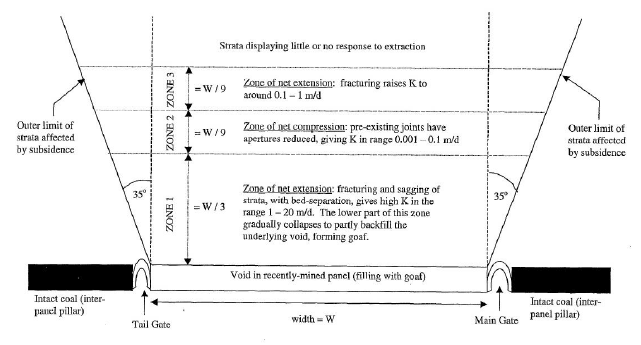
Unmined coal-bearing Carboniferous strata tend to form complex, multi-layered minor aquifers, with vertical and lateral variations - low permeability layers (of mudstone and other relatively impermeable rocks) interbedded with layers of more permeable sandstone or limestone. Intrusions of igneous rock (dykes, sills, plugs) and faults can also compartmentalise these aquifers. When mining has occurred the resulting "anthropogenically enhanced aquifer" (term coined by Banks, 1997) is also multi-layered and certainly complex, but with a generally higher permeability enabling larger yields to be obtained.
One advantage of the multi-layered nature of these mining-enhanced aquifers is the potential to abstract water from one depth interval and re-inject the used water at lower temperature to a different horizon. This is beneficial as obtaining consent to discharge mine water to surface or sewers is likely to be difficult, plus this type of circulating system maintains water levels in the subsurface while providing a hydraulic and thermal barrier (by intervening low permeability strata) which increases the time for thermal breakthrough (thermal "short-circuiting") to occur. The Shettleston scheme in Glasgow was designed in this way.
Water from abandoned mines is often of poor quality due to its chemical composition, and it can cause a range of environmental problems. A comprehensive description of the various issues and their occurrence in the UK is given by the Environment Agency, the Scottish Environment Protection Agency and the Coal Authority in their joint report, "Abandoned mines and the water environment" (Johnston et al., 2008).
Problems include low oxygen, acidic waters, which can have high concentrations of dissolved metals like iron which precipitate out when exposed to oxygen as the water is brought to the surface. Iron oxide flocculants have negative impacts; for example, making it difficult to re-inject water because the particles clog the voids in the subsurface, thereby reducing permeability.
Available technologies mean these issues need not prevent the water being used for GSHP, but the water chemistry must be tested and any problems accounted for in the design of the system. There is the potential for water to be treated following heat extraction and prior to re-insertion. The Coal Authority operates a pilot treatment and re-insertion scheme at Dawdon in County Durham and treatment and re-insertion issues have been addressed at the Heerlen scheme in the Netherlands (European Union, 2008).
6.5 Data and information availability for Scotland
6.5.1 Areal and vertical extent of mining
The Coal Authority holds the most comprehensive data describing the mining history of Scotland, with a large amount of data digitised for use in GIS. This includes 33 936 underground working polygons (with associated depth, date and seam extraction data) in 5 seams, 2,785 probable unrecorded working polygons (and associated depth), and 11 637 spine roadways (underground roadways connecting coal etc workings). Handling this large volume of spatial data is outside the scope of this project.
BGS also holds a large amount of information about mines; for example, the 1980s Environmental Geology Map ( EGM) series covers the Midland Valley of Scotland at 1:10 000 scale. The series includes locations of known adits and shafts in mined areas. The EGMs are available as georeferenced, scanned images, but the information within them is not digitised except in the Glasgow area, for full use in a GIS.
( http://www.bgs.ac.uk/discoverymetadata/13603135.html).
For this study, the most appropriate data on the areal extent of mining in Scotland was deemed to be the Coal Authority's polygon showing where a more detailed search of mine plans should be made when considering development ( Figure 17).
The vertical (depth) extent of mining in Scotland was calculated by generating a surface indicating the depth of mine workings across the Midland Valley. This was created using a dataset of all records in the BGS Single Onshore Borehole Index (SOBI: http://www.bgs.ac.uk/products/onshore/SOBI.html) that contained the word 'shaft' or 'pit'. These data were then filtered to remove those with a '0' start height, a '0' borehole length or those which started below ground level ( Figure 18). The surface was created by interpolation in GOCAD® software, and is displayed in Figure 20 to Figure 23. The volume of the mine-worked area ( i.e. from the base of the mine workings to land surface) is estimated therefore to be 6 x 10 11 m 3, or 600 km 3.
For more detailed studies, it would be necessary to have data on the number and thickness of seams mined (cf Campbell, 2010), and of the locations of shafts and roadways in the vicinity. BGS has already compiled much of this information for Glasgow (Campbell, 2010; Figure 24). Data for other parts of the Midland Valley are available digitally from the Coal Authority, or in paper or scanned image form from BGS.
Figure 16 Coal Authority mining search areas and locations of Midland Valley collieries listed in Table 9 and Table 10.
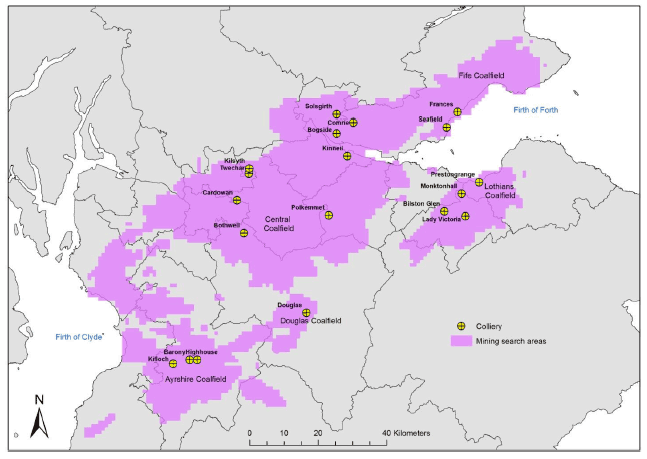
Figure 17 Mineshafts in the Midland Valley.
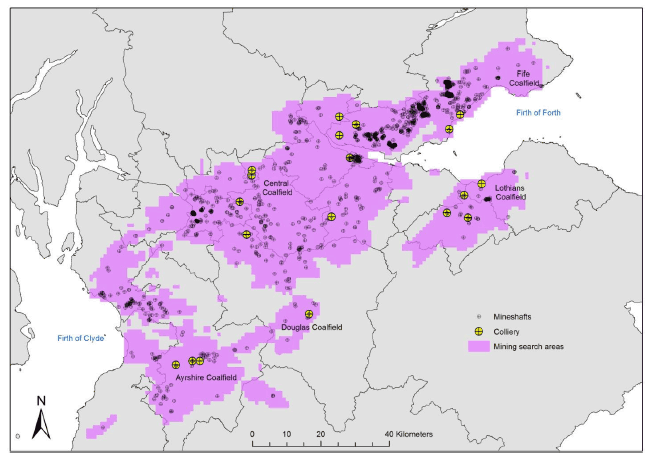
Figure 18 Depth of mine workings (interpolated from SOBI data), showing deepest workings in orange and red.
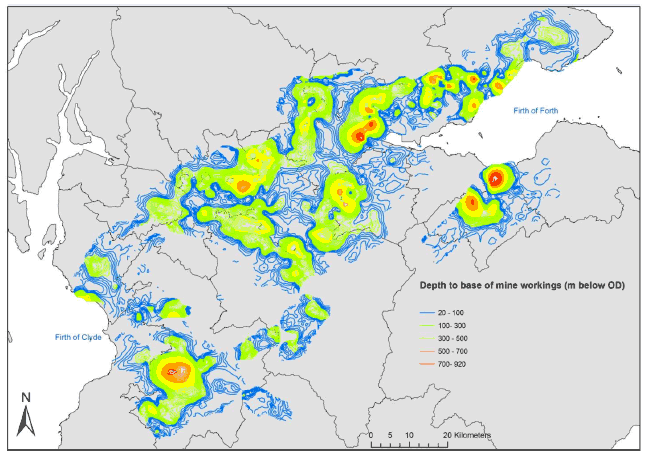
Figure 19 Depth of mine workings viewed in GOCAD ® (©Paradigm) 3D modelling software, showing deepest workings in orange and red.
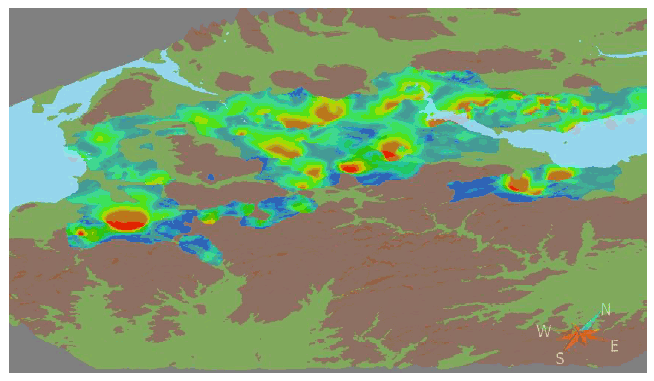
Figure 20 Depth of mine workings in the Lothians, Fife and Central coalfields, viewed in GOCAD ® (©Paradigm) 3D modelling software and showing deepest workings in orange and red.
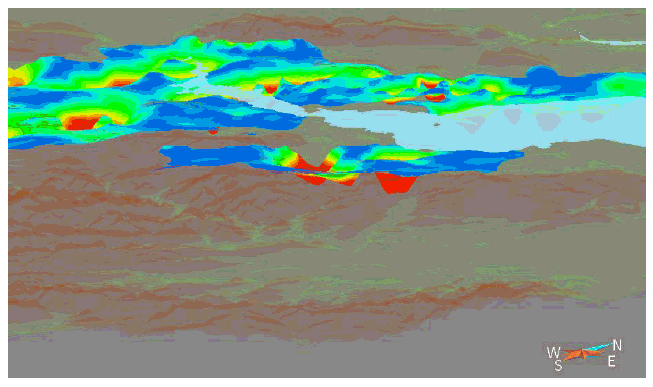
Figure 21 Depth of mine workings in the Ayrshire, Douglas and Central coalfields, viewed in GOCAD ® (©Paradigm) 3D modelling software and showing deepest workings in orange and red.
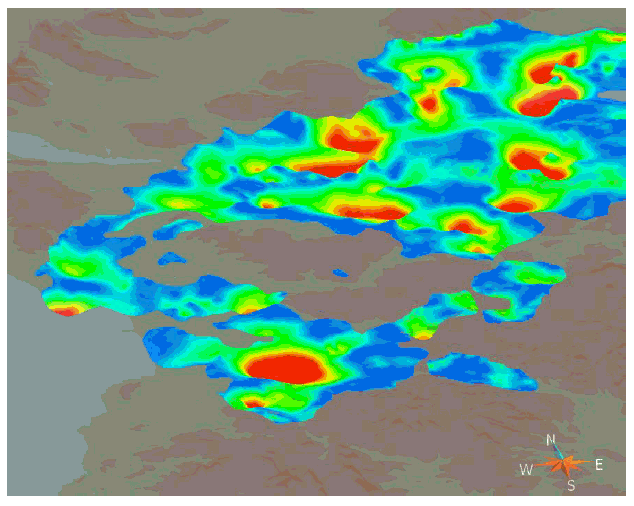
Figure 22 3D model of mined coal seams (yellow and blue surfaces), mine shafts (red sticks) and mine roadways (green, light blue and pink), beneath Glasgow's East End. Viewed in Virtalis/ BGS GeoVisionary software.
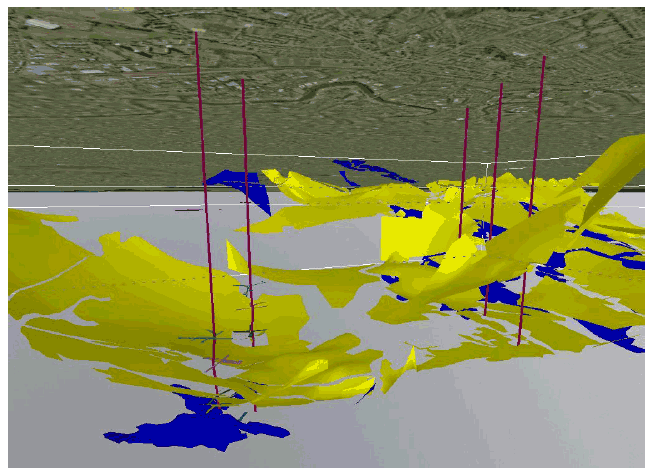
6.5.2 Porosity, hydraulic conductivity and connectivity
The additional porosity created by mining beneath a 5 km x 5 km square of Glasgow (NS66SW) was calculated utilising data relating to the number and thickness of mined seams (and taking into account the expected proportion of mined void to remain post-collapse) that were collated and digitised for the Glasgow 3D geological model (Crane et al., 2011, unpublished BGS report). The calculated increase in porosity for this block of rock is only about 0.14%, compared to an average porosity for the Scottish Coal Measures of about 10%. However, the increase in porosity will not be evenly distributed throughout the body of rock and, locally, will increase by more than this.
More importantly, the permeability will have been increased by orders of magnitude due to mining activities. This will enable pumping at much higher rates than in undisturbed strata.
A prime target for a scheme would be shafts and roadways ( Figure 23), as these will have permeability that is orders of magnitude higher than the surrounding disturbed strata. Data on the location of these can be obtained from the Coal Authority. Due to the volume of data, these were not used for this and for this national-scale study, but they would be important for site-specific investigations.
Figure 23 Monktonhall Colliery Underground Roadway: view looking along an underground roadway at Monktonhall Colliery, Midlothian, 1970s. This colliery produced coal from 1967 to 1997. Image courtesy of the Scottish Mining Museum.
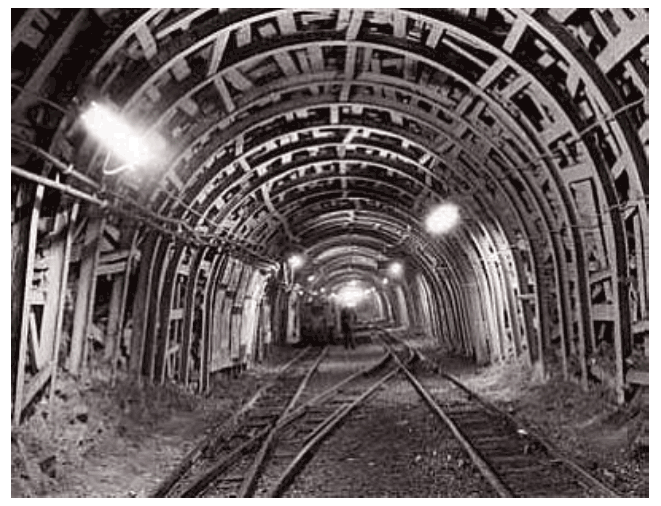
The two key parameters which influence the potential for getting heat from mine waters are the flow rate at which water can be abstracted from the subsurface without significantly depleting the resource at the site in question, and the temperature of that water.
It is very difficult to predict the likely flow rate (usually referred to as the borehole yield) that a particular borehole might obtain due to the great variability in mining-enhanced aquifers, but an analysis of available data enables us to establish a typical range of yield. It should be borne in mind though that very low-yielding boreholes are often not recorded, leading to data sets biased towards higher yields.
Available data for yields from the Carboniferous strata of the Midland Valley are collated in Table 7, organised according to the geological formation from which the yield is believed to be obtained. The final column notes whether the yield is clearly associated with mines. Examples of dewatering yields are given in Table 9.
In general, it is thought reasonable to expect a yield of about 10 l/s in mining-enhanced aquifers, from a borehole penetrating a reasonable saturated thickness of strata (minimum of 50 metres). For the purposes of the calculations of potential heat abstraction, a range of 5 to 25 l/s per borehole seems reasonable.
It is worth noting that vast volumes of water were pumped from mines during operation to maintain the water level below the working zone. The pumping rates did vary significantly: the examples given in Table 9 range from 13 l/s to 315 l/s. These values cannot be applied directly to the current study, but do give an insight into the amount of recharge that must have been occurring to require such high volumes to be pumped.
Table 7 Borehole yields (information from Robins, 1990; Hall et al., 1998; McAdam and Tulloch, 1985; Forsyth et al., 1996).
| Group | Formation (Fm) | Yield | Location | Associated with mines? |
|---|---|---|---|---|
| Scottish Coal Measures Group | Scottish Middle and Scottish Lower Coal Measures formations | up to 150 l/s from some working coal mines | Southern Midland Valley, east of Lanark | Yes |
| 2 to 5 l/s | Southern Midland Valley, east of Lanark | No | ||
| 75 l/s from 194 m borehole | Inveresk Paper Mills, Musselburgh | Yes | ||
| Many of the coal mines pumped water for drainage purposes at rates of up to 75 l/s | Southern Midland Valley, west of Lanark | Yes | ||
| Single borehole yields of 5 l/s are more typical | Southern Midland Valley, west of Lanark | No | ||
| Clackmannan Group | Passage Formation | Supports several moderate-yielding boreholes (up to 20 l/s) | Fife and Kinross | No |
| Strathclyde Group Inverclyde Group | Upper Limestone Formation Limestone Coal Formation Lower Limestone Formation | Up to 30 l/s from old mine shafts and adits | Fife and Kinross | Yes |
| Dewatering at 40 - 75 l/s over 140 hours per week from 165 m and 225 m | Prestongrange Colliery (NT 373 737), from the Limestone Coal Fm | Yes | ||
| 1.5 l/s from 9 m borehole | Longniddry (NT 438 765) | Probably not | ||
| 650 m 3/d (7.5 l/s) | Pencaitland, from the Limestone Coal | Not stated | ||
| 2 l/s from a 70 m borehole | Upper Limestone Fm at Loanhead (NT 292 661) | Probably not | ||
| 1 l/s typical yield | Southern Midland Valley, west of Lanark | Probably not | ||
| 5 Ml/d (60 l/s) from a well field drawing from the Upper Limestone Formation. Exceptional yields included: 30 l/s for 10 m drawdown, 15 l/s for 20 m drawdown, 1 l/s for 8 m drawdown. |
Denny. Boreholes 48 to 85 m deep; deeper boreholes had better yields, probably due to contact with mine workings. | Very likely in the deeper holes. | ||
| Typically small yields from Upper Limestone and Limestone Coal | Glasgow vicinity | No | ||
| Up to 10 l/s where mine workings intercepted | Glasgow vicinity | Yes | ||
| 25 l/s | Parkhead [ NS 624 647] | Yes | ||
| 14 l/s | Coatbridge [ NS 752 642] | Yes | ||
| 9 l/s drawn from old workings | Netherfield ( NS 618 647) | Yes | ||
| One 198 m deep borehole yielded 9 l/s for 9 m drawdown, but 3 adjacent holes provided negligible yield | Glasgow Garden Festival site, Govan (198 m hole at 5668 6475) | Possibly | ||
| Yields typically <0.5 l/s, rarely reaching 2 l/s | Southern Midland Valley, west of Lanark | Probably not |
Table 8 Historical mine dewatering rates (information from Robins, 1990; Forsyth et al., 1996; Cameron et al., 1998; Parker, 2011.)
| Dewatering rate | Location | Stratigraphical unit(s) |
|---|---|---|
| 40 - 75 l/s over 140 h week from 165 m and 225 m | Prestongrange Colliery [NT 373 737] | Limestone Coal Fm |
| 230 l/s constantly from 396 m depth | Bothwell Colliery [686 588] | Scottish Middle Coal Measures Formation |
| 150 l/s from 206 m depth | Kilsyth Colliery [715 779] | Limestone Coal Fm |
| 13 l/s for 12 hours per day from 317 m depth | Twechar Colliery [701 762] | Limestone Coal Fm |
| 30 to 55 l/s | Typical dewatering rates for mines in the Falkirk District | Limestone Coal Fm and/or Coal Measures |
| 35 l/s (Coal Authority pumping station; Parker, 2011) | Monktonhall Colliery, Midlothian | Limestone Coal Fm |
| 75 l/s (Coal Authority pumping station; Parker, 2011) | Polkemmet Colliery, West Lothian | Scottish Lower Coal Measures Formation |
| 120 l/s (Coal Authority pumping station; Parker, 2011) | Frances Colliery, Fife | Scottish Middle Coal Measures Formation, Scottish Lower Coal Measures Formation |
| 315 l/s (Coal Authority pumping station; Parker, 2011) | Blindwells Colliery, East Lothian | Limestone Coal Fm |
6.5.4 Recharge
It is assumed that mine water GSHP schemes will use a recirculation model to avoid the various issues associated with discharging to surface or mains, thus it is not necessary to know the natural recharge rate. As discussed above ( section 6.5.3), the large volumes of water removed during active dewatering of mines indicates that significant recharge does occur in these areas.
6.5.5 Groundwater levels
For this national-scale study, groundwater levels were not modelled (assumed full thickness saturated); however, a site-specific study would need to obtain recent water-level data to ensure that an adequate saturated thickness of aquifer is present in the horizon to be targeted as part of a feasibility study.
6.5.6 Temperature of mine waters
The temperature of mine waters generally increases with depth according to the geothermal gradient (see Part 1 of this report, and in particular section 2.1.3). It is not simple, however, to predict the temperature of water pumped from a borehole, as water of different temperature may be entering the borehole at different depths. Groundwater exchanges heat with the rocks it flows through but the degree of equilibration will depend on the rate of groundwater flow through the aquifer.
A compilation of mine water temperatures for boreholes in the Midland Valley shows a fairly narrow spread of temperatures ( Table 10). The data in the table have been sorted by depth, but this shows no correlation to the observed water temperature. Mine water temperatures range from 12 to 21°C, with a mean (and median) of 17°C.
Table 9 Mine water temperatures for boreholes in the Midland Valley (extracted from Table 4)
| Borehole name | Grid reference | Depth (m) | Temperature (deg C) |
|---|---|---|---|
| Douglas Colliery | NS 830 300 | 239 | 12.2 |
| Bogside Colliery | NS 9564 8778 | 334 | 17 |
| Solsgirth Colliery | NS 9777 9329 | 387 | 21.5 |
| Barony Colliery | NS 5105 1971 | 411 | 17 |
| Highhouse Colliery | NS 5321 7202 | 436 | 18 |
| Polkemmet Colliery | NS 9190 6278 | 549 | 17 |
| Killoch Colliery | NS 4883 2130 | 655 | 17 |
| Bilston Glen Colliery | NT 2996 6320 | 670 | 15 |
| Lady Victoria Colliery | NT 3294 6666 | 768 | 18 |
Robins (1990) stated that "The temperature of groundwater circulating at shallow depths in Scotland generally ranges from 8 to 12˚C".
6.5.7 Mine water chemistry
On the whole, the quality of the water does not impact on GSHP schemes as long as the system installed is designed appropriately ( section 6.4.3). Water chemistry therefore is not considered in this study. Published data are available and should be considered for site-specific situations.
6.6 Methodology
Two methods for estimating the low-enthalpy geothermal resource for a site or an area are considered here. Firstly, the total resource, or 'heat-in-place', can be estimated for a body of rock. This, however, will always be many times larger than the potentially exploitable resource, which is dependent on many factors - hydrogeology, amount of heat in the system, pumping rate, re-injection potential, efficiency of heat extraction, economic considerations, etc. Secondly, the rate of heat output can be estimated based on estimates of sustainable abstraction rates and likely groundwater temperatures ('flow rate method').
6.6.1 "Heat in place" estimate for mined areas
Geothermal resource estimates were made for the UK in the 1980s using an approach which calculated the heat resource in both the groundwater and the matrix (Downing and Gray, 1986). The Geothermal Resource is calculated using the full equation:
 joules
joules
where :
H 0 = the [total] Geothermal Resource, i.e. the total heat contained in the aquifer (joules)
 = porosity
= porosity
ρ w and ρ m = densities of water and matrix respectively in g/m 3
c w and c m = specific heats of water and matrix respectively in J/g/°C
V = volume of aquifer in m 3
 = mean reservoir temperature in °C
= mean reservoir temperature in °C
 = mean annual ground temperature in oC.
= mean annual ground temperature in oC.
Then, a maximum recovery factor is applied to assess the proportion of the total which may be available for development; the Identified Resource. This is more favourable when the cooled water is re-injected to the aquifer via a separate borehole (a doublet system) as opposed to when the water is dumped: when a doublet system is used, more heat is recovered from the aquifer by the re-injected water. The maximum recovery factor is defined by Lavigne (1978) as:
 F
F
where:
F is a factor related to the hydraulic properties of the aquifer and to the method of abstraction.
From experience in the Dogger aquifer in France, where water is re-injected into the aquifer using a doublet system, F = 0.33. In calculating the Identified Resource for the UK, an F value of 0.25 was used for a theoretical doublet system and 0.1 for a single well where rejected brine is disposed of subsequent to heat extraction. These values are best estimates and need to be tested through further research and practical experience. However they do provide relative estimates for comparison.
The standard methodology for considering the potential output of an open-loop ground source heat system is described by Banks (2008). The calculation includes the anticipated groundwater flow rate from the borehole(s) feeding the system; here termed the "flow rate method". The flow rate is multiplied by the specific heat capacity of water and the temperature drop in the water across the heat pump:
G = Z .  . S VCwat
. S VCwat
Where:
G is the ground source heat (heat extracted from the ground) (W)
Z is the flow rate from the borehole(s) supplying the heat pump (L s -1)
 is the temperature drop across the heat pump (˚K). For example, if groundwater is abstracted at 12°C and returned to the aquifer at 7°C,
is the temperature drop across the heat pump (˚K). For example, if groundwater is abstracted at 12°C and returned to the aquifer at 7°C,  would be 5°C (1°C is equivalent to 1°K).
would be 5°C (1°C is equivalent to 1°K).
S VCwat is the specific heat capacity of water, 4180 J K -1 L -1 (joules per degree Kelvin per litre).
This calculation gives a value for the ground source heat output in watts (joules per second).
6.7 Calculations/Results
6.7.1 Heat in place estimate for the mined areas of the Midland Valley of Scotland
The heat resource in a body of rock can be simply calculated to provide an 'order of magnitude' estimate. Recovery of this energy will depend on a wide range of factors but the figure is useful in relation to the calculated demand density. The calculation is based on many assumptions of variables, but these are clearly stated and can be changed if more accurate data become available.
6.7.2 Geothermal Resource of the mined areas of the Midland Valley
Assuming the average surface temperature is 10°C and there is an average geothermal gradient in the Midland Valley of 30°C/km ( section 4.2.1 and Figure 6), then the temperature at 200 m depth will be about 16°C and the temperature at 500 m will be about 25°C. Assuming heat is abstracted from pumped groundwater and a drop of 10°C (replacing the temperature difference between mean aquifer and surface temperature in the calculation) is applied to the whole block then the potential Geothermal Resource is calculated as follows:
H 0 = [  ρ wc w + (1 -
ρ wc w + (1 -  ) ρ mc m]V(
) ρ mc m]V(  -
-  ) joules
) joules
where:
H 0 = the [total] Geothermal Resource, i.e. the total heat contained in the aquifer (joules)
 = porosity (0.1)
= porosity (0.1)
ρ w and ρ m = densities of water (1 x 10 6 g/m 3) and matrix (2.5 x 10 6 g/m 3) respectively
c w and c m = specific heats of water (4.18 J/g/°C ) and matrix (0.84 J/g/°C ) respectively
V = volume of aquifer (6 x 10 11 m 3)
θ m - θ g = 10°C drop in temperature applied.
H 0 = [(0.1 x 1 x 10 6 x 4.18) + (1-0.1)( 2.5 x 10 6 x 0.84)] x 6 x 10 11(10)
= 1.38 x 10 19 J
= 1.4 x 10 13 MJ.
The temperature drop of 10°C is fairly conservative, so there can be a high degree of confidence in the above result.
Conversion from MJ to kWh:
1 kWh = 3.6 MJ, thus 1.4 x 10 13 MJ = 3.85 x 10 12 kWh
= 4 x 10 12 kWh.
So, the Geothermal Resource of the mined areas of the Midland Valley is estimated to be
1.4 x 10 13 MJ or 4 x 10 12 kWh.
We consider this to be the total available heat resource (heat in place) in the mined areas of the Midland Valley, but in fact additional heat will flow into this body of rock from the Earth's interior, and also solar radiation at shallower levels, replenishing the source to some extent. Only a small proportion of the total heat resource is likely to be recovered/recoverable.
Identified Resource:
If a maximum recovery factor of 0.625 (F = 0.25) is applied this would equate to an Identified Resource of 5*10 8 kWh/km 2.
In this study the accessibility of the resource is calculated using the "flow rate method" (sections 6.6.2 and 6.7.4) which applies hydrogeological understanding to the problem, so less heed is taken of the Identified Resource calculation.
6.7.3 Geothermal Resource by unit area
It is useful to know, on average, what the Geothermal Resource is per unit area. Dividing the Geothermal Resource for the whole area by the number of square kilometres in the mined area provides us with a value of Geothermal Resource per km 2:
= 4 x 10 12 kWh / 4.8 x 10 3 km 2
= 8*10 8 kWh/km 2.
6.7.4 Accessible heat resource from the mined areas of Scotland
The flow rate method has been applied to estimates of thermal resource on regional and national scales. This is done by estimating an available water yield (given as a flow rate) for an area and calculating how much energy can be extracted from that water, or by gathering information about a number of sites, and summing the thermal resource estimates for those sites to produce a regional figure. In mining areas, data usually relate to pumping water to permit mining to proceed and not to the understanding of the hydrogeological regime and water balance. Of necessity, assumptions have to be made and estimates can have large margins of error. These estimates do however identify where more data are required to increase confidence to proceed.
In Section 6.5.3 a yield of 5 to 25 l/s per borehole seems reasonable. Assuming that this yield could be achieved in boreholes spaced on a 500 m grid across the mined area, i.e. 4 boreholes per km 2, we suggest that the groundwater could be exploited at a rate of 20 to 100 l/s/km 2. This rate of pumping would be far in excess of the natural recharge rate and would be unsustainable without re-injection of the water to the aquifer after heat has been extracted.
Example calculation
Using the equation (see section 6.6 for definition of parameters)
G = Z .  . S VCwat
. S VCwat
where:
Z = 60 l/s/km 2 yield
 = 10 ˚C temperature drop
= 10 ˚C temperature drop
S VCwat = 4180 J K -1 L -1
G = 60 x 10 x 4180
= 2.5 x 10 6 W/km 2
= 2508 kW/km 2.
Range of values
The possible range in values of energy that can be extracted per square kilometer is given in Table 10. Taking the middle of the parameter ranges, we can say that some 2.5 MW/km 2 could be obtained on average in the mined areas of Scotland.
Multiplying this value by the number of square kilometres in the mined area (4.8 x 10 3 km 2) gives a very approximate estimate of the rate at which heat could be accessed of 12 000 MW, or 12 GW.
We consider this to be an estimate of the accessible resource, i.e. how much heat energy could theoretically be extracted from the mined areas of the Midland Valley bearing in mind the hydrogeological constraints (how much water can in practice be abstracted).
Table 10 Thermal potential per km 2 based on flow rate method, taking into account possible variability in borehole yields and groundwater temperature .
| Yield (L/s/km 2) | Temperature drop 5°C (kW/km 2) | Temperature drop 10°C (kW/km 2) | Temperature drop 15°C (kW/km 2) |
|---|---|---|---|
| 20 | 420 | 840 | 1260 |
| 60 | 1254 | 2508 | 3762 |
| 100 | 2090 | 4180 | 6270 |
6.7.5 Proportion of Scotland's heat demand
PB Power (2004) estimated that the total heat demand in Scotland was approximately 55.8 TWh per annum. By 2020, annual demand is expected to be 60.1 TWh (Scottish Government, 2009).
Heat usage is rarely constant; when sizing heat pump systems it is usually assumed that domestic systems run for 1,800 hours per year, and commercial systems for 1,500 hours per year. Dividing the 2020 figure for annual demand by the domestic value of 1,800 hours per year gives a rate of heat use of 0.033 TW, or 33 GW. The commercial value gives a figure of 40 GW.
Comparing this to the estimated rate at which heat could be accessed from mine waters using GSHP, 12 GW ( section 6.7.4), we can estimate that the mine waters could theoretically provide the equivalent of approximately one third of Scotland's heat demand. However, the actual contribution is likely to be significantly less for three main reasons:
- heat cannot be transported efficiently over large distances, so would only be used above or close to suitable mine workings;
- a proportion of mine workings will not be suited to heat extraction;
- heat delivered by GSHP is most effectively used in new build properties; existing building stock will likely require extensive upgrading to benefit from mine water heat.
The Scottish Government has set a target of 11% of non-electrical heat demand in Scotland to come from renewable sources by 2020 (Scottish Government, 2011). Based on the calculations set out above, heat from mine waters has the potential to make a significant contribution towards attaining this target,
6.7.6 How many years supply?
If Scotland accessed as much of the heat in the mine waters as possible (2.5 MW/km 2: section 6.7.4), it may last for approximately 37 years. This ignores the reality that additional heat would flow into the mined areas from Earth's interior and solar input. Practicalities also mean that it is unlikely to be possible to access the heat at the maximum possible rate, in which case the supply that is tapped will last longer than the above estimate. Nor does the estimate take into account potential recharge from using the minewaters as a source of cooling during the summer.
6.8 Future possibilities
The Coal Authority dataset on the spatial extent of abandoned mines ( section 6.5.1), with detail regarding the number and depth of seams worked in different locations, could be used to produce spatially varying estimates of the heat resource in Scotland's mine waters. The data could be used in a GIS to divide Scotland's mined areas into parcels based on categories such as the depth of mining and number of seams mined. Any proposed scheme to utilise heat from mine waters would require a comprehensive geological and hydrogeological desk study and modelling of data prior to any site-specific works. The desk study should make use of the detailed information available from the Coal Authority where possible.
All estimates could be greatly improved if the GSHP industry could provide data about schemes that have already been installed. Access to a mine water GSHP scheme during the drilling stage would enable hydrogeologists to assess the state of the subsurface and do some tests to assess permeability. It would also be valuable to have a research project that monitored the functioning of a Scottish GSHP mine water scheme over a number of years to look at issues such as thermal breakthrough.
Although not considered in this study, mines other than coal mines could also be used for mine water heat recovery. Within the Midland Valley, the greatest potential is likely to be from limestone, ironstone and oil-shale mines ( Figure 11). Smaller, more local, mine water resources also exist outside the Midland Valley, for example lead mines in more rural areas such as at Leadhills and Wanlockhead in the Southern Uplands.
6.9 Conclusions
- Mine water in abandoned workings in Scotland's Midland Valley might form an important low enthalpy resource for space and domestic hot water heating, and related uses. Our estimates indicate that there is a significant amount of heat (12 GW) in place in the mined areas of the Midland Valley, and that due to the additional permeability provided by mining this heat should be accessible to GSHP schemes. We estimate that mine waters could potentially provide a significant proportion of Scotland's heat demand.
- However, there are many assumptions and generalisations in this attempt to characterise the heat potential of the Midland Valley and further work is recommended.
6.10 Recommendations
R4 One or more site-specific studies should be conducted utilising existing information (including Coal Authority and BGS data), developing a detailed 3D model of the mine workings, gathering new information on borehole yields and permeability, and assessing the technical feasibility of installing an open loop GSHP system perhaps in combination with other forms of energy. The Glasgow area would be an obvious target given the availability of BGS 3D geological models and other previous studies as well as the expected scale of the ongoing developments and urban regeneration.
R5 The GSHP industry should be encouraged to deposit key data on installed schemes in a national archive, similar to that for borehole data held by BGS to facilitate further modelling and potential exploitation of available thermal resources.
Contact
There is a problem
Thanks for your feedback